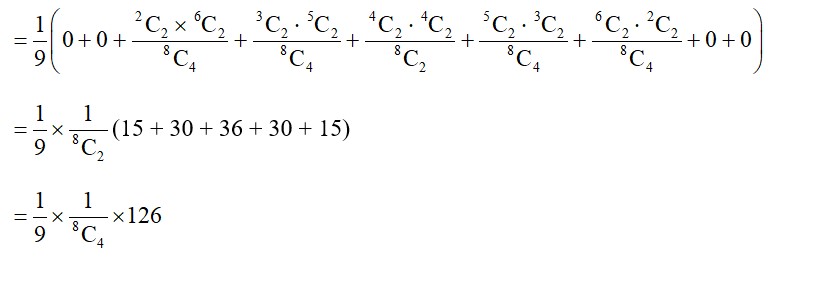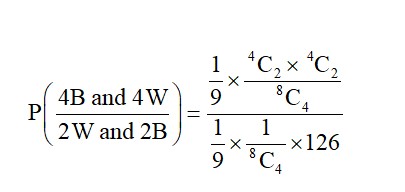60. Two dice are thrown simultaneously. If X denotes the number of sixes, find expectation of X.
60. Two dice are thrown simultaneously. If X denotes the number of sixes, find expectation of X.
-
1 Answer
-
60. Two dice thrown simultaneously is the same the die thrown 2 times.
Here, X represents the number of sixes obtained when two dice are thrown simultaneously. Therefore, X can take the value of 0, 1, or 2.
∴ P (X = 0) = P (not getting six on any of the dice) = 25/36
P (X = 1) = P (six on first die and no six on second die) + P (no six on first die and six on second die)
=2 (1/6 x 5/6) = 10/36
P (X = 2) = P (six on both the dice) =1/36
Therefore, the required probability distribution is as follows.
X
0
1
2
P (X)
25/36
10/36
1/36
Then, expectation of X = E (X) =∑ X iP (Xi)
= 0 x 25/36 + 1 x 10/36 + 2 x 1/36
= 1/3
Similar Questions for you
P (2 obtained on even numbered toss) = k (let)
P (2) =
P (
If x = 0, y = 6, 7, 8, 9, 10
If x = 1, y = 7, 8, 9, 10
If x = 2, y = 8, 9, 10
If x = 3, y = 9, 10
If x = 4, y = 10
If x = 5, y = no possible value
Total possible ways = (5 + 4 + 3 + 2 + 1) * 2
= 30
Required probability
P (2W and 2B) = P (2B, 6W) × P (2W and 2B)
+ P (3B, 5W) × P (2W and 2B)
+ P (4B, 4W) × P (2W and 2B)
+ P (5B, 3W) × P (2W and 2B)
+ P (6B, 2W) × P (2W and 2B)
(15 + 30 + 36 + 30 + 15)
Let probability of tail is
⇒ Probability of getting head =
∴ Probability of getting 2 heads and 1 tail
ax2 + bx + c = 0
D = b2 – 4ac
D = 0
b2 – 4ac = 0
b2 = 4ac
(i) AC = 1, b = 2 (1, 2, 1) is one way
(ii) AC = 4, b = 4
(iii) AC = 9, b = 6, a = 3, c = 3 is one way
1 + 3 + 1 = 5 way
Required probability =
Taking an Exam? Selecting a College?
Get authentic answers from experts, students and alumni that you won't find anywhere else
Sign Up on ShikshaOn Shiksha, get access to
- 65k Colleges
- 1.2k Exams
- 679k Reviews
- 1800k Answers


